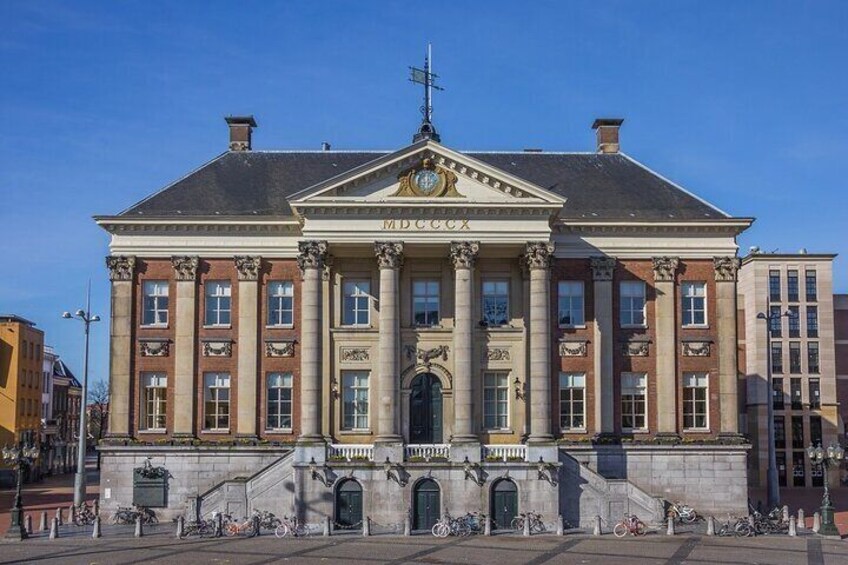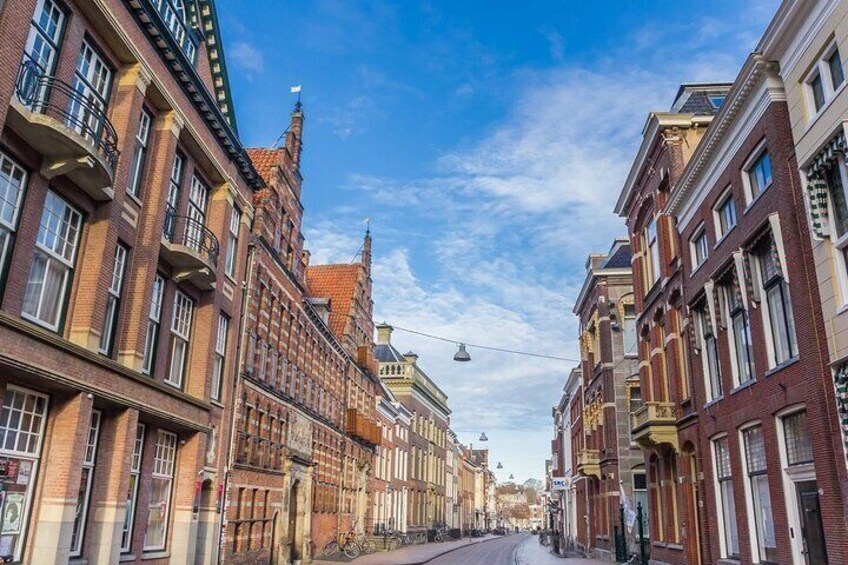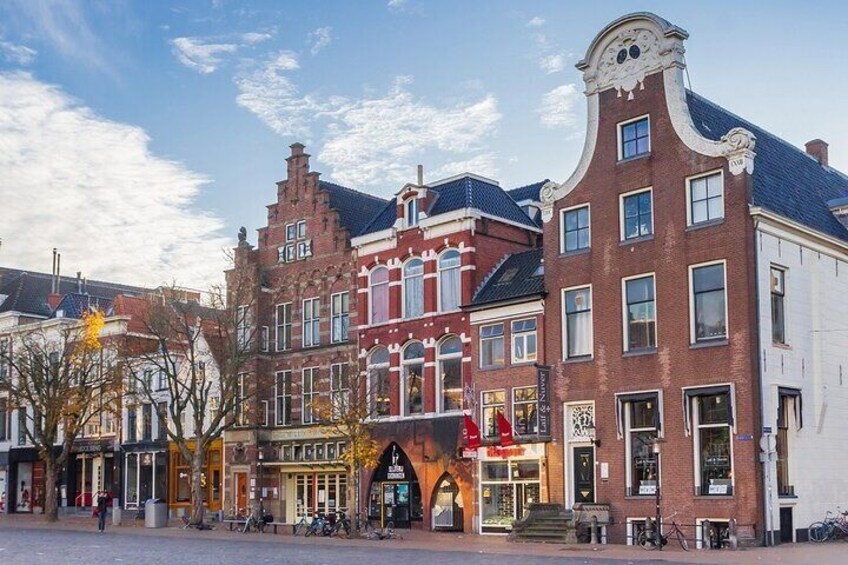




Explore Groningen City with Self-Guided GPS and Audio Tour
By Niki Your TravelBuddy
Free cancellation available
per adult
Features
- Free cancellation available
- 2h
- Mobile voucher
- Instant confirmation
- Multiple languages
Overview
Join our immersive walking tour of Groningen and explore top attractions like the Grote Markt, Martini Tower, and Forum Groningen. Adventure seekers and families alike will love discovering hidden gems like the peaceful Prinsentuin and the innovative Groninger Museum. With real-time GPS guidance, you’ll gain insider knowledge of the city vibrant culture, rich history, and local traditions. Experience stunning architecture, captivating stories, and unforgettable encounters that make Groningen truly special. This tour offers a unique and memorable experience for anyone eager to see the best of the city. Book now and enjoy an enriching journey through Groningen’s heart
Activity location
- Vismarkt
- Groningen, The Netherlands
Meeting/Redemption Point
- Pronk
- 56 Vismarkt
- 9711 KV, Groningen, Groningen, The Netherlands
Check availability
Explore Groningen City with Self-Guided GPS and Audio Tour in Multilingual
- 2h
- Opening hours: Wed 7:00 am-7:00 pm
- English
Price details
NZ$12.41 x 1 AdultNZ$12.41
Total
What's included, what's not
- App
- Audio and Written Guide
- Bottled water
Know before you book
- Service animals allowed
- Public transport options are available nearby
- Infants and small children can ride in a pram or stroller
- All areas and surfaces are wheelchair accessible
- Transport options are wheelchair accessible
- Wheelchair accessible
- Suitable for all physical fitness levels
- Travel time is already included in the total duration time
Activity itinerary
Vismarkt
- 5m
The name says it all... this is where fish used to be sold. There is a suspicion that the street pattern of the city centre of Groningen is based on that of cities from Roman times. The Vismarkt would then have been intended as the central square of the city. Now there are beautiful buildings, including Vismarkt 56.
Groninger Museum (Pass by)
It is the science museum of Groningen! Since 1934, the museum has been located in the academic heart of this student city. If you want, you can view the collection full of science, nature and culture, I walk calmly further and turn right into the Muurstraat one of the nice little streets of Groningen
Forum Groningen
- 15m
The world of today and the possibilities of tomorrow. At the Forum you will find films, exhibitions, events, festivals, games, Storyworld, books, and talks. You can visit the Forum for free, go inside and visit the roof where you have a beautiful view of the city
Martinikerk (Pass by)
the oldest church in Groningen. Around the year 1000 the first stone church was located at the Martinikerkhof. This was a Romanesque church made of tuff stone. Around the year 1220, a larger church in Romano-Gothic style stood on the same site.
The Martinikerk was then a three-aisled cruciform church with a high central nave and lower side aisles. Round apses closed off the choir and the side aisles. There are still many traces of this construction phase in the church. Examples are the round windows and the recessed fields with decorative brickwork. This can be clearly seen where you are now standing, in the north and south facades of the nave. Around 1220, this church had also become too small for the growing city population.
In the 15th century, which was an economic golden age for the city, this cruciform church gradually grew into the current Martinikerk.
Martinitoren (Pass by)
The Martinitoren is one of the symbols of the city of Groningen. It is the most famous and highest tower in the city. Groningers also affectionately call the tower {D’Olle Grieze}: ‘the old grey one’.
On the spot where the Martinitoren now stands, there were two other towers. The first was built in the thirteenth century and was about thirty metres high. This building can still be found on the seal of the city of Groningen. This first tower was destroyed by a lightning strike in 1408.
About twenty years later, the Martinikerk was expanded in Gothic style and a new tower was also built. This second tower was about forty-five metres high. It was built of stone and wood and collapsed in 1468. A few years earlier, a large fire had raged in the tower after a lightning strike.
Stadhuis Groningen (Pass by)
City hall of Groningen, the stronghold of local democracy. Until the end of the 18th century, the city hall consisted of a collection of buildings, some of which were still medieval. But for more than two centuries it has been positioned in the middle of the Grote Markt. The building is the result of the first architectural competition in the Netherlands, in 1774. This was won by architect Jacob Otten Husly. Due to a lack of money and an invasion by French troops around 1800, the project was delayed considerably and work was halted for years. The town hall was not put into use until 1810. With its Dutch classicist, neoclassical architectural style, it is in any case a national monument of the first order. In the years 2020-2022, the town hall was completely renovated.
Het Goudkantoor (Pass by)
This exceptionally beautiful building in Renaissance style was built in 1635. The order came from the province: the building was intended as a tax office.
The purpose of the beautiful building can still be read from the text on the facade: ‘Date Caesari quae sunt Caesaris’. This literally means ‘Give the emperor what is the emperor’s.’ After the French rule that lasted until 1814, it was unclear for a long time who had the right of ownership: the city or the province. It was not until 1843 that clarity was provided and the now dilapidated building was renovated. At that time, the provincial coats of arms on the facades were also replaced by those of the city. The building owes its name Goudkantoor to one of its users: the office of the guarantee of gold and silver works. This office used the upper floor of the building from 1814 to 1887.
Pelstergasthuis
- 5m
The Pelstergasthuis is the oldest guesthouse in the city. It is assumed that it dates from the 13th century and was the only guesthouse in Groningen until 1342. The Pelstergasthuis was first mentioned in 1267 when Pope Clement IV gave permission to build a chapel and a cemetery on this site. The current building dates from various periods between the 14th and 19th centuries. The church is the oldest part of the guesthouse that is still standing. Inside hangs the oldest bell in Groningen, dating from 1459. Feel free to take a look inside.
Synagogue Groningen
- 5m
Small and not exactly beautiful, that is what the previous synagogue of Groningen looked like. Since 1756 it had been doing modest service in the {Kleine Folkingestraat}, also called Jodenstraatje.
In 1903, the municipal authorities approached Architect Kuipers. Although he had designed dozens of churches, he had little knowledge of synagogues. To gain inspiration, he made a study trip through Germany. In Berlin, Kuipers was impressed by the Moorish or oriental style of, among other things, the synagogue on Oranienburgerstrasse. The building was built at a time when German Jews wanted to express their oriental roots in their synagogue architecture. The striking oriental dome on the building and many horseshoe arches in the outer walls and interior were synonymous with ‘Jewish’ at the time.
Akerk
- 5m
The Akerk, which is about eight hundred years old. Around 1200, a chapel was built on the eastern bank of the river A. It quickly grew into a large basilica, a church building with a floor plan in the shape of a cross. The church was dedicated to Saint Nicholas, the patron saint of sailors. The river A was an important waterway for trade. The Akerk was not mentioned in a written document for the first time until 1246. In the fifteenth century, a lot of work was done to enlarge the church. As a result, around 1495, the Akerk largely took on the shape it still has today. The church, built for Catholic worship, was taken over by the Protestants during the Reformation in 1594. Everything that reminded of Catholic use disappeared from the interior at that time. Until 1970, Protestant services were held in the Akerk. One thing has not changed in eight centuries: the church is at the heart of city life.
Location
Activity location
- Vismarkt
- Groningen, The Netherlands
Meeting/Redemption Point
- Pronk
- 56 Vismarkt
- 9711 KV, Groningen, Groningen, The Netherlands
Best Deals on Things to Do
Experience the wonders of the world up close with great deals on things to do near and far. We offer one-of-a-kind activities that allow you to explore Groningen your way. Whether you love nature, culture, food or a bit of adventure, we have the perfect activity for you.